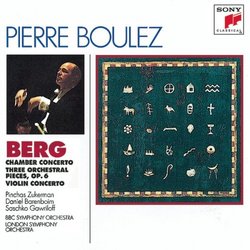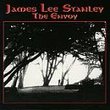| All Artists: Alban Berg, Pierre Boulez, BBC Symphony Orchestra, London Symphony Orchestra, Daniel Barenboim Title: Berg: Chamber Concerto; Three Orchestral Pieces, Op. 6; Violin Concerto Members Wishing: 2 Total Copies: 0 Label: Sony Release Date: 12/5/1995 Genre: Classical Styles: Forms & Genres, Concertos, Historical Periods, Modern, 20th, & 21st Century, Instruments, Strings, Symphonies Number of Discs: 1 SwapaCD Credits: 1 UPCs: 074646833124, 007464683312 |
Search - Alban Berg, Pierre Boulez, BBC Symphony Orchestra :: Berg: Chamber Concerto; Three Orchestral Pieces, Op. 6; Violin Concerto
 | Alban Berg, Pierre Boulez, BBC Symphony Orchestra Berg: Chamber Concerto; Three Orchestral Pieces, Op. 6; Violin Concerto Genre: Classical
No doctrinaire theorist, Berg composed communicative, emotional music without compromising his technical sophistication and atonal allegiances. The Chamber Concerto has its knotty moments, but also considerable charms. Bar... more » |
Larger Image |
CD DetailsSynopsis
Amazon.com essential recording No doctrinaire theorist, Berg composed communicative, emotional music without compromising his technical sophistication and atonal allegiances. The Chamber Concerto has its knotty moments, but also considerable charms. Barenboim's big-hearted, romantic pianism plays off Gawriloff's tart violin, the piquant winds, and Boulez's controlled leadership. The Three Pieces is as close as Berg ever came to writing a symphony; its mix of powerful orchestral outbursts and elegant section writing are reminiscent of Berg's beloved Mahler. The Violin Concerto's ardent warmth and tender lyricism, expressing Berg's meditations on death and redemption (including a direct quote from a Bach cantata) after the untimely passing of Manon Gropius, make it irresistible. The fine performance offers an alternative view to classic older recordings by Louis Krasner and Isaac Stern. Including most of his key instrumental works, this disc is an ideal introduction to Berg's genius. --Dan Davis Similar CDs
|
CD ReviewsExemplary Berg 04/30/2000 (5 out of 5 stars) "It remains to be seen how kindly history will judge Pierre Boulez the composer. However, by virtue of this release alone, his credentials as a conductor are the stuff of which legends are made. Of the atonalists, Berg is in some ways the most "messy." He was not as orthodox as his classmate Webern when it came to applying twelve note techniques. His music is dense, and hopelessly complex to be sure, but under Boulez's deft touch it also seems to live and breathe. Perhaps Boulez the composer has contributed much to the triumph that is Boulez the conductor. He unpacks this music as only someone who can also construct it might. The Three Orchestral pieces, which I have heard multiple times to varying degrees of satisfaction, is given a very sensible but appealing reading here. The Chamber Concerto, featuring Daniel Barenboim in the first of several recordings he would make of this piece under Boulez's baton, is also outstanding. Pinchas Zukerman gives a very credible reading of the Violin Concerto. For individuals on the fence about Berg, this recording should be required material. For those who already admire Berg, this recording does not need to be required because it will sell itself after even after the most casual of listenings. This recording is a testatment to the brilliance of one of this century's least understood composers, and the artisty of one of this century's greatest conductors." Rich, alluring works of early modernism R. Hutchinson | a world ruled by fossil fuels and fossil minds | 08/27/2002 (5 out of 5 stars) "This is a stunning record in every respect -- the compositions, performances, conducting, and recording -- a jewel of Boulez' many recordings for Sony. The "Violin Concerto" is the only piece here that has become part of the standard repertory, and the performance is beautiful, if not as well known as Mutter's. The "Chamber Concerto" is rigorously structured, and sounds more like Webern than the other two pieces. My favorite, though, is "Three Pieces for Orchestra," the closest Berg came to writing a symphony. This dramatic music blends the influence of Mahler with that of Schoenberg, which seems to be Berg's forte. 20th century masterworks!" An economical introduction to Berg, but at least 2 of the pi Christopher Culver | 07/18/2008 (4 out of 5 stars) "The three composers of the Second Viennese School each turned atonal writing to different ends. Schoenberg explored turbulent expressionism, and Anton Webern wrote remarkable crystalline miniatures, but when Alban Berg adopted new modernist methods he never entirely left Romanticism behind. This mid-price disc makes for an economical introduction to Berg's music, where Pierre Boulez, one of his strongest supporters, leads the BBC Symphony Orchestra.
The three-movement "Chamber Concerto" for violin, piano and 13 wind instruments was written between 1923 and 1925 and shows a mastery of the 12-tone method. The first movement begins with a brief little motto incorporating the names of his friends Arnold Schoenberg and Anton Webern, and then proceeds through a series of variations. For the most part, this sounds like an especially zany Mahler, and Berg's Viennese heritage is especially evident in the langsamer Walztempo. The second movement is an Adagio, much more tranquil than the first both in its slower tempo and its reduced scoring as the piano mainly sits out. The last movement is a round that subjects a succession of different melodies to the same rhythms. While I like how this recording has each of the variations in the first movement on its own track, I much rather prefer Boulez's later recording with the Ensemble Intercontemporain (a DG disc) for its better sound quality--it's an IRCAM recording. The Three Orchestral Pieces op. 6 (1914-15) are one of Berg's early efforts and date from an era of free atonality. The work consists of a Prelude, Reigen (Round Dances), and a March, all of which are linked in an egghead fashion by common melodic cells, but each has its own very individual character. The Prelude is very Mahlerian, but with application of Klangfarbenmelodie. The Reigen is dance-like, but about as far away from village tunes as you could get. The March is also somewhat Mahlerian, but the innovative scoring is forward-looking (am I the only one who hears an inspiration for Gubaidulina's symphony?). The "Violin Concerto" (1935), with the dedication "to the memory of an angel", is the one work of Berg's that seems to have finally entered the standard repertoire. Written after the death of the young Manon Gropius, daughter of Alma Mahler-Werfel and Walter Gropius, it meant as a work of constant elegy sometimes tempered with praise of a beautiful young soul, but at other times it gives in to the darkest feelings of mourning and catastrophe. The 12-tone system is used here, but with strong echoes of traditional harmony. It opens with the lushest sounds of clarinet and harp, moves towards the softest touches of strings, and ultimately roars thundering crescendos pregnant with meaning. Since Berg left the door open to traditional harmony, he brings in two objets trouvees that link the work to a long tradition before it. The most readily noticeable is Bach's chorale "Es ist genug", variations on which provide the basis of the second movement. Another is a Carinthian folk song Berg knew in his youth, when he had an illegitimate child with a family maid, giving the concerto a "secret programme". There are, of course, many other performances of Berg's violin concerto out there, and I must say that this performance by Pinchas Zukerman pales next to that by Anne-Sophie Mutter on a DG disc. Zukerman on Sony simply can't compete in sound quality and poise. Plus, this recording was made before examination of the original sketches in the 1980s revealed that a key part of the work was muddled in the published score. All in all, what we have here is good stuff. This being 2008, when film music has gone to much greater extremes of "dissonance" than Berg ever approached, this composer needs a wider audience, and I'm sure that he'll appeal to all but the most conservative of classical listeners. If you have lots of money to spend, I'd recommend seeking out the later DG recordings of the Chamber Concerto and the Violin Concerto. However, this Sony disc is highly recommended for budget-minded fans of new music." |

 Track Listings (16) - Disc #1
Track Listings (16) - Disc #1


